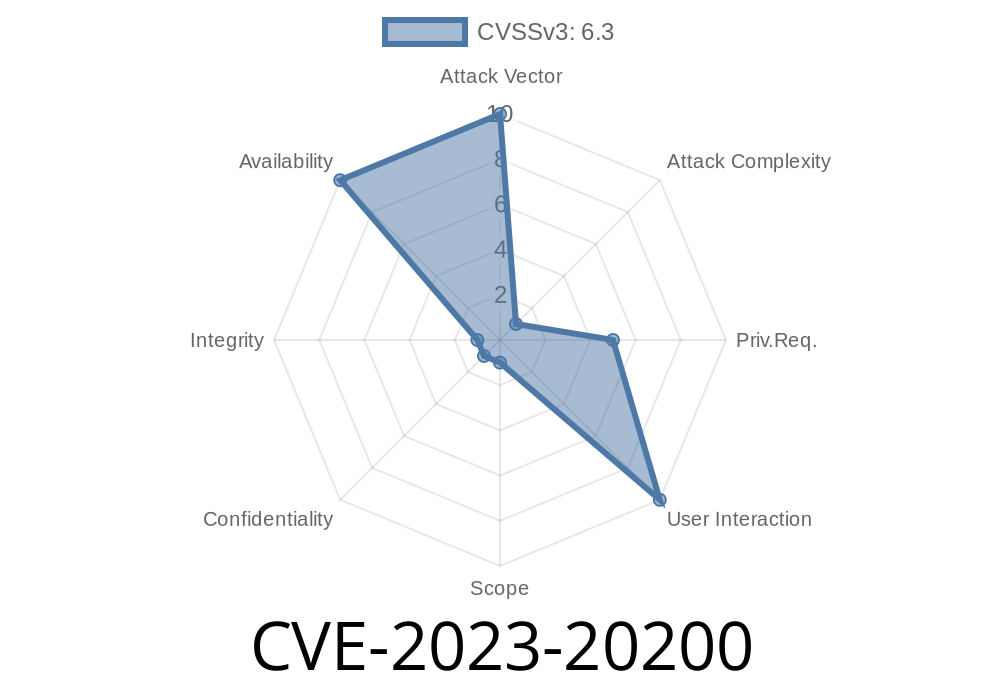If you’re working with enterprise network equipment, especially from Cisco, you should be aware of CVE-2023-20200. This vulnerability impacts the Simple Network Management Protocol (SNMP) service in Cisco FXOS Software for Firepower 410/930 Series and UCS 630 Series Fabric Interconnects. In this article, let’s break down what this vulnerability is, how it can be exploited, and what you should do to protect your systems.
What Is CVE-2023-20200?
At its core, CVE-2023-20200 is a denial of service (DoS) vulnerability in Cisco products running SNMP. This flaw can be triggered by an authenticated, remote attacker — meaning the attacker needs SNMP access (a community string for v2c or user credentials for v3).
What happens? The affected device can restart or become unresponsive when it processes specially crafted SNMP requests, essentially causing a DoS condition. This bug is present in all supported SNMP versions: v1, v2c, and v3.
Cisco UCS 630 Series Fabric Interconnects
_All running certain versions of FXOS software are in the risk zone. You should check the Cisco advisory for a list of those affected FXOS versions and fixed releases._
How Does the Exploit Work?
The vulnerability comes from how SNMP requests are handled by the device. Some crafted SNMP messages are not processed correctly, corrupting device memory or causing unexpected restarts.
Attacker discovers the SNMP community string (through sniffing or guessing).
2. Using any SNMP tool (like snmpwalk or snmpget), they send a malformed SNMP packet to the device’s SNMP port (default 161).
Scenario: Exploiting with SNMPv3
1. Attacker has valid SNMPv3 credentials (could be a former employee or someone who found leaked creds).
The attacker constructs and sends a malformed SNMPv3 packet.
3. The device is unable to safely handle the request, so it reloads and becomes unavailable temporarily.
Example of a Crafted SNMP Request
While Cisco didn’t publish the exact malformed SNMP request, we can demonstrate how standard tools could be used with crafted parameters. Here’s an example using Python and pysnmp:
from pysnmp.hlapi import *
# This is just a template showing how an SNMP packet can be crafted.
# The vulnerable crafted request would require the actual malformed content, which is not publicly disclosed.
iterator = getCmd(
SnmpEngine(),
CommunityData('private', mpModel=1), # SNMP v2c
UdpTransportTarget(('target-device-ip', 161)),
ContextData(),
ObjectType(ObjectIdentity('1.3.6.1.2.1.1.1.')) # Normally, you send a real OID; an attacker may try a malformed OID
)
errorIndication, errorStatus, errorIndex, varBinds = next(iterator)
if errorIndication:
print(errorIndication)
else:
for varBind in varBinds:
print(' = '.join([x.prettyPrint() for x in varBind]))
A real attack would involve manipulating the SNMP PDU (Protocol Data Unit) in some unexpected way to trigger the bug.
Proof-of-Concept (PoC)
Note: There is no official public PoC exploit due to the risk this poses, but tools like snmpbulkwalk, snmpset, and scripts using pysnmp can be adapted if the attacker knows the right malformed payload.
For example, using snmpbulkwalk (with a known community)
snmpbulkwalk -v2c -c public target-device-ip 1.3.6.1.2.1.1
Changing the OID and structure (with malformed OIDs or parameters) can sometimes cause unprotected, vulnerable devices to crash, depending on the nature of the vulnerability.
## References / Original Sources
- Cisco Advisory: CVE-2023-20200 SNMP DoS Vulnerability
- NIST National Vulnerability Database CVE-2023-20200
Update FXOS Software:
Cisco has released patches. Always run the latest tested version. Check your software version and upgrade if necessary.
Restrict SNMP Access:
Limit SNMP queries to only known, trusted management stations. Use ACLs to allow SNMP only from specific IPs.
Use Strong Credentials:
Use complex community strings (for SNMPv2c) and strong user/passwords (for SNMPv3). Remove unused SNMP users.
Conclusion
CVE-2023-20200 is a powerful reminder that even management protocols like SNMP can be abused to take enterprise equipment offline. As a network defender, you should treat all management access as highly sensitive and restrict and protect it accordingly.
Stay safe, and always patch early!
*This post is an exclusive, simplified analysis based on publicly available advisories. For more details and the latest updates, always consult original vendor advisories.*
Timeline
Published on: 08/23/2023 19:15:08 UTC
Last modified on: 09/07/2023 17:58:03 UTC
